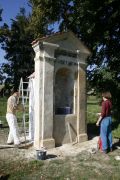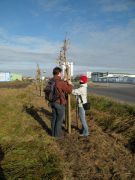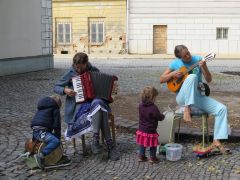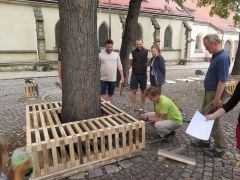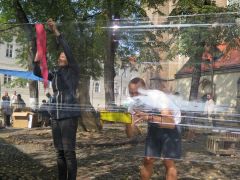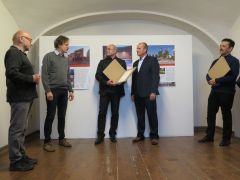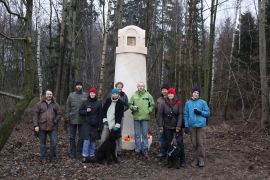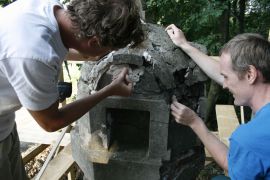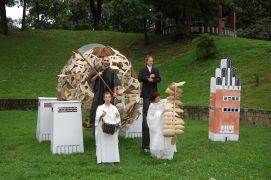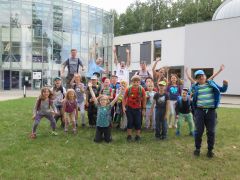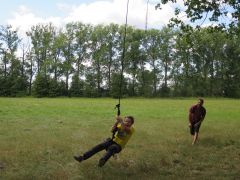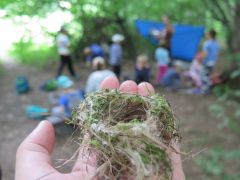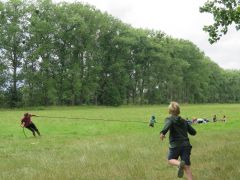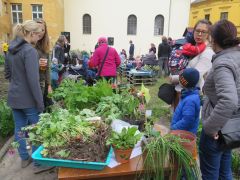Za Opavu – “For Opava” – is a long-running association that can be described as a multifaceted organizer of local cultural and social life in the Opava region. Its central goals are the protection of cultural patrimony, the environment and healthy living conditions in the city of Opava and its surroundings. The members of the group actively work as political cultural opposition to city leadership, offering cultural commentary on Opava and its regional planning.
AF: What was the impulse behind starting the group Za Opavu?
KS: Like many other non-profit organizations, our association was founded on the basis of dissatisfaction or conflict. In particular with the city of Opava, which never worked together with the public, never discussed large projects and plans that concerned all citizens of Opava.
When did you first meet?
We came together for the first time at the end of 2006. The association’s focus was naturally determined by the profession of its members. We were originally a society of historians, restorers, builders and conservationists. So, we focused on cultural patrimony. Gradually, we added ecological specialists, on and our scope expanded to encompass environmental issues. The third pillar of our activities – community, somehow came along the way. We turned to the locals and drew them into the action. We organized public debates until the people and the city began to take us seriously.
Did some specific cause spur you to action?
Yes. The city started to remake the historic center. It began with náměstí Osvoboditelů (Liberators Square). They began to surround it with walls which were to commemorate of the former city walls. However, the walls appeared in a place where the original castle never stood, and worse, they were made of yellow brick. It was a quite large and controversial intervention in the urban conservation zone.
So, it was like modern yellow brick walls?
That’s right. An enormous and nonsensical project. The wall was, at the same time, to be anti-noise. We tried to stop it. We began a public discussion, people started to debate among themselves and the first petition was created. However, we did not want to build our activities on protests, and so we focused on the restoration of small religious monuments that were in disrepair. In 2007, we received our first grant from the Via Foundation to repair the chapel in Brumovice. The results were soon visible, and we liked it. With each monument repaired, our community grew, and we got to know both each other and how to work with cement.
And how did it turn out with the yellow walls?
Unfortunately, they built it. We entered the negotiations late and so the petition did not prevent the construction. What was important, however, was that, thanks to our petition, for the first time people had the opportunity to comment on a public project that concerned them. That’s why our association was established.
If you compare the atmosphere in the city, the people’s ability to speak out, or to understand their surroundings in a larger context, between the time you started and now, has there been any shift?
We have been able to bring greater experience to the cases that followed and have become more directly involved in the direction of other controversial projects. For example, we prevented the construction of a large Plaza shopping center right in the city center. That was a similar situation to the one in Liberec, when developers completely demolished the historic part of the city. We wanted nothing like that in Opava. After much negotiation, EIA proceedings and appeals, we succeeded. In the end, Plaza did not build in Opava.
Gradually people became more interested in the public space and wanted to participate in decision making processes. They understood that what was happening in the city could affect them, and that they could comment on it. The city then had to start taking on the public, including Za Opavu, as partners. After all, cooperation is always more effective.
You handled the Slezanka case very well. What exactly was it about?
Five years ago, we started a petition against the construction of a shopping center right on Horní náměstí (Upper Square) in Opava. It was connected to the existing Slezanka department store, which was built on the square in the 1970s. Behind Slezanka there is a small park and it is true that the free space created by the demolition of war-torn houses has some potential for transformation. The developer came with intention of demolishing Slezanka and building a large multifunctional building. However, they had not adequately dealt with issues of parking and deliveries. At that time, Opava had a big problem with an excess of supermarkets and was dealing with the depopulation of the city center.
What did you do?
We entered into negotiations with the city and spurred a public discussion. We printed Slezankoviny, in which everyone had a say – developers, the city, historians, architects, urbanists, and conservationists. Our primary concern was that people could form their own opinions and then, if they wanted, to express it. On this basis, the city chose a different strategy, to discuss and plan with community involvement. The space was, with the help of specialists, dealt with in detail, architecturally and urbanistically. The working groups came up with, for example, computer maps of the city. For the first time, there was attention given to the space based on its social and cultural impact. Public discussions revealed that people wanted to leave part of the park in place, and to build flats with small shops on the ground floor, preferably with services that were lacking in the center. We feel that the city management’s change in attitude as a result of the event was a great achievement.
How did you manage to pay for a print run of 60,000?
The Via Foundation gave support to that, and we also worked together with the law firm Frank Bold, which provided us with free services and helped us with the text of the petition.
You invest a lot of energy in education. What is the target group?
We understand that if we want to effectively convey cultural values, we must start with children early in life. This gave rise to a unique project called Memorial, an educational program connected with the relationship to cultural heritage, which we began to bring to the schools. I myself created several projects on diverse topics, countless excursions and a number of annual programs, not only in elementary schools, but also in one kindergarten. Even children at the age of four are able to understand what culture is, it’s just that educational approaches and methods differ.
Each year you award the Josef Maria Olbrich Architecture Award. How would you describe its importance?
This prize is named after architect and Opava native Josef Maria Olbrich, and has been awarded since 2007. It is given based on the quality of an architectural project, new building or reconstruction in the Opava area. The concept also includes a series of lectures, European Heritage Days and the Opava Cultural Evening “Noční kupé” (Night Coupe). The goal is to support dialogue on environmental issues. We are pleased that over the years the JMO Award has gained prestige among professionals and the general public. The concept of giving a prize on an independent, non-commercial and professional basis has proven to be quite unique in the public space, and so it has been highly valued.
The Opava “Noční kupé” mentioned above is your version of Pecha Kucha Night. Where does it differ, and why did you change the format?
The Pecha Kucha project was founded by a group of people interested in architecture, and within 6 minutes and 40 seconds must present 20 images. Our selection has broadened to include all interesting persons in the region and they may present in any way they like. So, for example in the seventh year, we had a poetry reading, a theater performance, performance art, and meditation. However, the time limit has remained. There are always around ten presenters who are given in a chosen subject, which each of them deals with in their own way. The evenings have been very powerful experiences.
All of this is not a job for a few enthusiasts. How big is your team?
The team varies according to the focus of the projects. The core consists of five people, who draw in all the rest. They are joined by other members according to interest and need, plus volunteers. For instance, the distribution of the 60,000 copies of Slezankoviny was largely undertaken by strangers. Each came for two parcels, put them on a bicycle, and delivered them into the mailboxes.
How often does the core team meet?
The selection committee meets monthly. Otherwise we generally have about twenty-five members, some drop out, others join, but the active core still consists of five to eight people. Others join for different projects or have taken on specific continuing tasks. For example, they manage Facebook and the web site, photograph events, communicate with the media, and so on.
Are there efforts to professionalize the organization?
During the entire active life of our organization, there have been no employees. From the beginning, we have been doing everything on a volunteer basis. Monetary rewards are not a priority, and I think that’s because we simply enjoy it and it makes sense to us. Without grants and subsidies, like honoraria to experts, space rentals, and other services and materials, it would be difficult to realize our activities. In recent years we have been regularly supported by the city of Opava, the Ministry of Culture and Education and the Czech Architecture Foundation.
What do you think Za Opavu’s main purpose is?
Nonprofits such as ours are able to provide necessary services that no one else can. This is what I see as irreplaceable in the current system. Officials do not have much time to work and communicate with people — it takes time. We are the first in the region to offer educational programs and camps for preschool children, as well as educational programs focused on cultural issues. We choose long-standing problems that have not yet been solved or that society considers too difficult. For example, before planning the restoration of a monument, we first look on the List of the Most Endangered Monuments of the Czech Republic. If we observe a decrease in interest in the public space, we help make it more accessible, perhaps make it more playful …
Where do you think the strength comes from to keep the members active?
We give strength to each other. The great thing is, someone gets an idea, and everyone else thinks it’s crazy. But when we start thinking about it together, it begins to develop and we can knead it into a final realization. This formative process from idea to realization is irreplaceable, and it is replenishable. And when you see that the people to whom you pass it on enjoy it or benefit from it, that's all more powerful.
For thirteen years of the association’s existence, you have been its chairman. How has your relationship with it changed over the years?
I have experienced several phases. From the initial enthusiasm and awareness that there were few of us and we had many projects in our heads, to the negative feelings that some members might be more active than others, to reconciling to the fact that, whatever we do must be enough if we have only own our free time and everyone does what they can and does it the best they can. I have become used to not using the word “can’t” and to going back and again opening closed or even locked doors. Working for the association is daily personality development, just like raising children at home.
What have you learned during this time?
I am always learning the art of communication. It sounds trivial, but in order to bring things about, we first need to talk to each other. There are five of us in the committee, there is always a vote. But for me a consensus is always better than a compromise. The crucial thing is that even a small group of people can change big things. And the fact of the association’s independence is important. But it is also essential to remember that even a project that we consider to be great may not be acceptable to the local people.
Do you encounter situations when the original intention is not understood?
Yes. During the first chapel repairs, Za Opavu went to a neighboring village, repaired the chapel, but people did not care whether or not it was in disrepair, or that is now fixed or not. They treated us as intruders and the chapel again fell into disrepair. We have learned that local support of such projects is important. Paradoxically, for me, is that it is often best to do nothing. Don’t work against the natural flow. I have found that, if we want something a very badly, often the results are negative. Sometimes it is better to want it just a little bit, or to give something more time to develop, or come at it from another angle.
Are you talking about the purposeful expenditure of energy?
It is best when we enter a process where the situation is already underway, ripe for change, and then it will be enough simply to nudge it, before going all in to change something in the face of a system that fights back tooth and nail. Otherwise, it’s a complete waste of energy. In the early days of the association, the prevailing belief was that we ourselves were the most capable ones. More recently, we are focused on a more sustainable approach, that of helping others do it for themselves.
Can you mention other associations that you know from your area and which are worth your attention?
Certainly, Bludný kámen Association, with which we often cooperate on cultural events, then Vodárenská věž Opava or the Brontosaurus Movement in the Jeseník area. These organizations have strong leaders and it is obvious to the organization. I also appreciate the activities of Okrašlovací spolek Za krásnou Ostravu and the Museum of Hlučínsko.
How were the Agosto grant funds used?
With this grant, we are very happy to transform our educational programs. We are already working on a new system for the schools, and we believe that we will be able to test these programs this year.
Where do you see Za Opavu in five years?
This is a difficult question that concerns all members of the association. So far, it looks like we will be happy to continue doing successful projects. Cooperation and community remain a priority. We will continue to take on new challenges, the more provocative, the better.
Kateřina Skalíková has led the Za Opavu association since 2007, where she is mainly responsible for educational programs, but also participates in other projects. She is employed at the Opava Local Action Group, working on the educational project Local Action Plans (MAP) for the regions of Opava and Vítkov. She is also the regional coordinator for Post Bellum for the program Stories of Our Neighbors.
